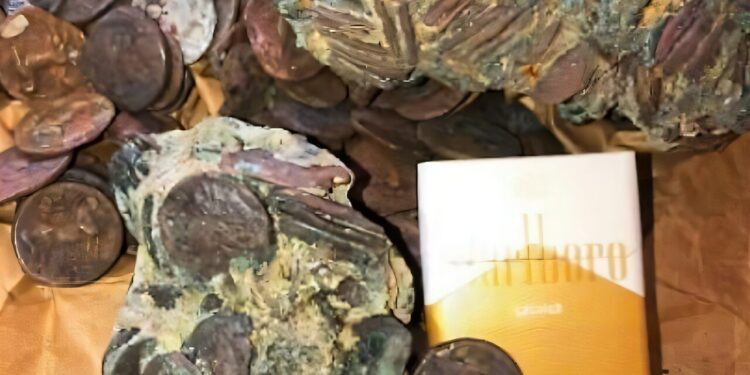Presumed treasure of Punic coins from the Tunisian coast. Photos sent by email to an antique store in Oslo by the seller. Credit: Oslo Police at Roland and Vison in 2025
In a study published in the journal Libyan studiesProfessor Håkon Roland and Dr Paolo Visonà examined the 2022 case concerning the seizure of 30 Punic bronze coins by Norwegian authorities.
The coins, which were part of a 200 kg hoard, were analyzed and determined to likely have originated in Carthage around the end of the Second Punic War (218-201 BC).
The study examines the legal frameworks surrounding cultural heritage crime and provides insight into the recent rise in the illicit trade in antiquities.
The 30 Punic coins seized from a Tunisian seller in Oslo in March 2022 were initially offered to a coin dealer located in Oslo. The seller had provided the coin dealer with photographs and videos showing massive quantities of corroded coins being loaded into a van.
Aware of the suspicious nature of the coins, the coin dealer contacted the Oslo police, who in turn requested assistance from the Museum of Cultural History at the University of Oslo. After the successful seizure, the Norwegian Ministry of Culture coordinated their repatriation to Tunisia.
Unsurprisingly, the seller never revealed details about the discovery location, and to this day, no one knows exactly where the treasure was. The amount and level of corrosion suggests that the parts likely came from a wreck or submerged coastal structure.
The coins were available in two denominations: 24 larger, heavier coins and six smaller coins, all depicting the image of the goddess Tanit on one side and a horse in front of a palm tree on the other. The similar artistic style, wear patterns, and goddess hairstyle matching late Second Punic War billion coins indicated that the coins were likely all created by the same Carthaginian mint, probably during the Second Punic War.
From the limited archaeological examples of similar coins, it appears that the circulation of these coins was largely restricted to North Africa, with only a few examples having been found in Europe, notably Dalmatia, Menorca and Croatia.
Coins appear to have stopped circulating around 205 BC. After the Second Punic War, only low-quality coins (shekels) were issued to finance military operations.
The seized coins were likely more valued due to their relatively good condition, weight, and metal content. From similar examples showing traces of silver surfaces, it is speculated that these coins may have been initially issued as billons. If this is the case, Gresham’s law (where precious money is saved and less valuable money circulates) would explain their absence in the archaeological record of most Tunisian sites.
Despite limited archaeological documentation, these pieces are far from rare, with many having flooded the market in recent decades. Coins are particularly vulnerable to illicit trade because they can be easily found with metal detectors and easily tampered with due to their portability.
“The increase in sales of Carthaginian and other coins (particularly Illyrian coins, e.g. from Ballaios) since the 1980s can be attributed to multiple interrelated factors, including regime changes, unregulated and increased use of metal detectors, lack of ad hoc legislation, increased opportunities for criminal activity due to open borders between several European countries, and corruption at different levels of law enforcement in some regions from Europe and North Africa”, explains Professor Roland.
Likewise, modern platforms such as eBay, social media, private websites, WhatsApp and Telegram have made it easier to find interested buyers, organize sales and expand the market beyond elite collectors.
Trafficked items are difficult to trace and their contexts become confusing. “It cannot be assumed that the information provided by coin dealers on the provenance of coins is credible, especially if the coins were acquired under questionable circumstances,” warns Professor Roland. “Coin dealers (and similar dealers, to be fair) are careful not to incriminate themselves. Same for coin collectors.”
Professor Roland highlights the importance of public awareness: “We are actively working to raise public awareness about the trade and trafficking of cultural heritage goods. The general public should be aware that there is a significant international trade in looted cultural objects.
“Regions affected by war, conflict and social unrest are particularly vulnerable to looting and smuggling of these items, and organizations such as Interpol, WCO, UNESCO, ICOM and Blue Shield are increasingly focusing on these issues.
“Information on the provenance of items offered for sale is often incomplete or fabricated, and it can be extremely difficult to distinguish between legal and illicit items. Individuals wishing to purchase an item should consider where it comes from, whether it is subject to export restrictions in the country of origin, and, if so, whether an export permit exists.”
Written for you by our author Sandee Oster, edited by Sadie Harley, and fact-checked and edited by Robert Egan, this article is the result of painstaking human work. We rely on readers like you to keep independent science journalism alive. If this reporting interests you, consider making a donation (especially monthly). You will get a without advertising account as a thank you.
More information:
Håkon Roland et al, Carthaginian bronze coins from a treasure found off the coast of Tunisia, Libyan studies (2025). DOI: 10.1017/lis.2025.10021
© 2025 Science X Network
Quote: Numismatic analysis integrates legal frameworks to trace illegally traded Carthaginian coins (October 30, 2025) retrieved October 30, 2025 from
This document is subject to copyright. Except for fair use for private study or research purposes, no part may be reproduced without written permission. The content is provided for informational purposes only.



